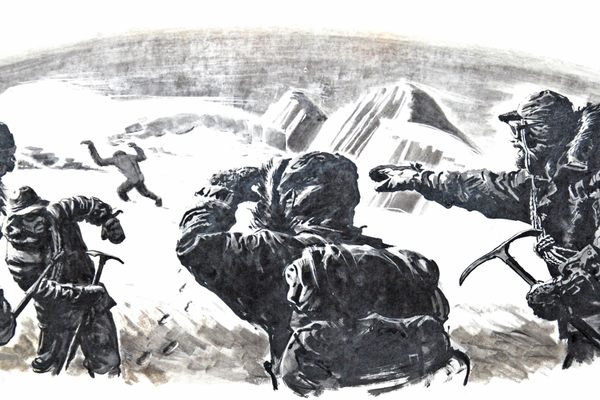Objects of Intrigue: Yeti Scalp
YETI SCALP
Brought to the Explorers Club from a remote Himalayan monastery
c.1960
Explorers Club, New York City, New York
High in the Himalayan mountains, the legend of a huge, hairy man-beast dates back to antiquity, but Western attention was not drawn to the so-called “Yeti” until the race to conquer Everest heated up in the years following WWI.
In 1921, British explorer Charles Howard-Bury, as part of the official Mount Everest Reconnaissance Expedition, reported seeing enormous footprints, which his local guides quickly attributed to the mysterious yeti. These guides called the creature “metch kangmi,” meaning (approximately) “filthy snowman.” It was almost immediately mistranslated in the press as “abominable snowman,” thus creating the enduring nickname for the creature.
In 1925, the Greek photographer N.A. Tombazi reported an eyewitness encounter, describing a creature who looked “exactly like a human being, walking upright and stopping occasionally to uproot or pull at some dwarf rhododendron bushes. It showed up dark against the snow and as far as I could make out, wore no clothes.”
Edmund Hillary and Tenzing Norgay
In 1953, soon to be famous mountaineers Edmund Hillary and Tenzing Norgay came across mysterious footprints in the snow in the remote Barun Khola mountain range.
1959 dispatch of guidelines concerning the yeti from the US government
All these sightings led to some concerns about what might happen should a creature actually be encountered, and the US government responded with a set of guidelines for expeditions, including that a yeti “must not be killed or shot at except in an emergency arising out of self defense.”
In 1960, Edmund Hillary returned to Nepal to investigate the legend of the yeti, and the two yeti scalps (and a hand) held at remote mountain monasteries, then regarded as the ultimate proof of the yeti’s existence.
The Explorer’s Club shared the history of their extraordinary artifact of Hillary’s expedition:
In the fall of 1960, Sir Edmund Hillary and Marlin Perkins journeyed to Kathmandu, Nepal, to investigate the reports and legends about the Abominable Snowman, called by the Sherpa name Yeti. An important part of the evidence for the existence of this creature was the Yeti Scalp, a venerated object kept for over 200 years at the Gompa, or temple, in the village of Khumjung.
Upon examining this scalp, Perkins, as Zoologist for the team, concluded that it could not be scalp tissue. A search of available animal hides in the region led to the conclusion that the scalp had been fabricated from the hide of the Himalayan serow - a goat antelope.
A Himalayan serow
A villager we recruited carved a wood mold to match the original size. After cutting and shaping the serow hide over the mold, and adding a touch of henna color from tea made by boiling leaves, they produced the duplicate, seen here, of the centuries old sacred scalp.
With the permission of the village elders and the government of Nepal, both the original and its newly made duplicate traveled to the United States, then to France and Great Britain. Scientists examined them and all concurred that the original yeti scalp was also fabricated from the hide of Antilocapi Sumathiensis: the serow goat.
The original was returned to the people and gompa of Khumjung, where it remains to today. This duplicate was presented by Dr. Carol Perkins, and Sir Edmund Hillary to the Explorer’s Club in November, 1998.
SEE IT FOR YOURSELF:
THE EXPLORERS CLUB, New York City
The yeti scalp, amongst many other wonderful treasures, is on display in the trophy room at the Explorers Club
46 E 70th St New York, NY 10021
OBJECTS OF INTRIGUE is our fortnightly feature highlighting extraordinary objects from the world’s great museums, private collections, historic libraries, and overlooked archives. See more incredible objects here>











Follow us on Twitter to get the latest on the world's hidden wonders.
Like us on Facebook to get the latest on the world's hidden wonders.
Follow us on Twitter Like us on Facebook